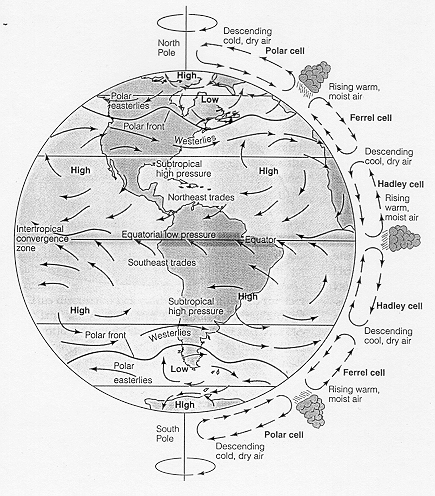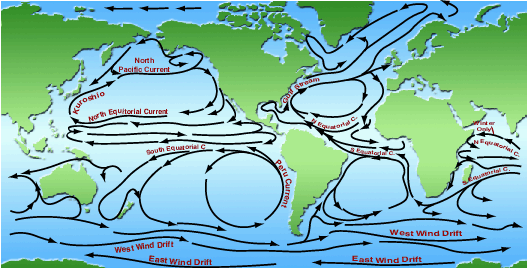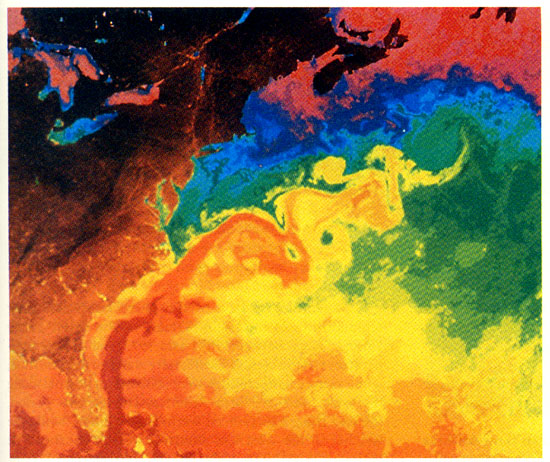 Do you have a question you would like to Ask The Sietch? Contact us or post your question in the Forums, and we will do our best to answer it.
Do you have a question you would like to Ask The Sietch? Contact us or post your question in the Forums, and we will do our best to answer it.
I got this one from the forums a couple of days ago.
Could you please elaborate on how exactly Global warming affects the wind causing changes in their patterns? I was unable to find a direct relationship between the two. I would be glad if you would let me know.
Thanks and Regards
Sujata
Thanks for your question Sujata. Lets start by talking about where wind comes from. The earth is a complicated place, lots of factors and lots of forces making things go all day and all night. That’s part of the reason its so interesting to live here. There are some things however we have discovered over the years. You most likely already know that the earth is tiled slightly along its axis, and that it goes around the sun. This means that different parts of our planet get different amounts of sun light. Among other things this tilt and solar orbit cause the seasons. It also causes the wind.
Because of the tilt, and the seasons, different parts of the earth are warm and cold at different times. If one part of the earth is warm (say the equator) and another part is cold (say the north pole) the air at the equator will warm up, warm things rise, so the air will start to rise up towards the sky, at the same time however because the earth is turning and because the earths gravity keeps the warm air from flying into space that air will start to move, this is wind. Wind is actually stored up solar energy. If we build wind turbines to capture the wind and make energy, we are really capturing solar energy that has been transformed into wind energy.

All the mountains, oceans, valleys and whatnot effect the way the wind goes, but for the most part these large scale patterns develop and stay pretty consistent. You have to remember that wind patterns are driven by the difference in temperature between different parts of the earth, the temperature difference between the surface of the earth and space, and the turning of the earth. It can get complicated fast.
So how does global warming figure into this? Global warming is causing a lot of the parts of the earth to get warmer. The poles are warming very fast, as are the oceans. So that means that places that used to be cold are now getting hot. So in some cases global warming is making wind patterns weaker. Because the difference in temperature is less the wind will blow less. This has a lot of consequences.
Winds carry water from wet places to dry places, so a low rain area becomes a desert when the wind doesn’t blow as often. It could also mean that an area that is somewhat dry because the wind is blowing the water away, might suddenly flood if the winds slow down. This is going on right now in the pacific.
Global warming caused by human activity has begun to dampen an important wind circulation pattern over the Pacific Ocean, and that could alter climate and the marine food chain in that area, a new study suggests.
It’s not clear what climate changes might arise in the region or possibly beyond, but the long-term effect might resemble some aspects of an El Nino event, a study author said.
El Ninos boost rainfall in the southern USA and western South America and bring dry weather or even drought to Indonesia, Malaysia and elsewhere in the western Pacific.
As for the Pacific food chain near the equator, the slowdown might reduce populations of tiny plants and animals up through the fish that eat them, because of reduced nutrition welling up from the deep, said the author, Gabriel Vecchi.
The slowdown was detected in shipboard and land-based data going back to the mid-1800s. It matches an effect predicted by computer climate simulations that trace global warming to a build-up of heat-trapping greenhouse gases, the researchers report. But simulations that consider only natural influences fail to produce the observed slowdown, Vecchi said.
So, it appears the slowdown is largely due to the man-made buildup of greenhouse gases, the researchers concluded. And the result lends more credibility to computer models that trace global warming to greenhouse gases, at least for their ability to forecast what will happen in the tropics, Vecchi said. (via)
You will notice that they also talk about ocean currents. Wind currents are a big driver of ocean currents. Ocean currents also have a lot to do with the weather. So changes in wind currents, change ocean currents, which further changes which parts of the earth are warm and cold, which effects the wind more which effects the ocean… you get the idea.

So global warming can slow wind down, because it lowers the difference in temperature between one place and another (mostly by making cool places warmer). Here is a picture of the warm gulf stream ocean current going up into the cold north Atlantic (remember ocean currents are pushed around by wind currents).

You can see how ocean currents move heat around the planet. In this example the gulf stream moves heat from the tropics up around Florida (making Florida very warm) and then jets off like that into the north Atlantic. This is why The UK has the climate it does. Without the warm waters from the gulf stream (and other ocean currents) the UK would be much colder than it is. Get out a map and draw a line from England over to Canada, and you will see they have very different climates, but are about the same distance north. All because of ocean currents and wind currents.
If wind currents were to stagnate it could radically change the climate. Warm places might become very warm, or they might suddenly get very cold, wet places could get dry or flood. Our system is a delicate balance, throwing it out of balance will have very hard to predict consequences.
There is one last thing that I have not talked about, the global conveyor belt (the Thermohaline circulation). Not all ocean currents are driven by the wind. There is one very large and very important current that is driven by wind, and salt.

This current is kind of special, it regulates the temperature of the planet, it keeps the warm parts from burning up and the cool parts from freezing solid. Some scientists even think that it was the stabilization of this great current that helped to keep the planet from continuing on its ice age/hot age swing ten thousand years ago.
Extensive mixing therefore takes place between the ocean basins, reducing differences between them and making the Earth’s ocean a global system. On their journey, the water masses transport both energy (in the form of heat) and matter (solids, dissolved substances and gases) around the globe. As such, the state of the circulation has a large impact on the climate of the Earth.(via)
The belt is also special because of the way in which it is driven. It moves around because of differences in the salinity of ocean water. Warm less salty water is less dense so it “floats” up. Salty water is more dense and so it sinks. This rising and sinking causing currents. In the same way that the differences in temperature can cause wind currents to flow, differences in salt content can cause ocean currents to flow. Saline differences do not move the water around the planet very fast, in fact this current takes a very long time to make one trip around the world, over 2000 years.
As the Greenland ice sheet melts due to global warming it is pumping a lot of fresh water into the north Atlantic (if you take a look at that picture you can see the belt makes a loop through the Atlantic). As this fresh water collects it will slow down the sinking of the salty cold water (because the water will be warmer and fresher), and may stop the conveyor belt altogether. If this happens the wind currents that used to pick up warm moist air from the gulf stream currents (the ones that keep the UK warm) might start to pick up cold air. This could have the effect of freezing out parts of Northern Europe. Meanwhile the heat that the current used to take away from the tropics would stay put causing the tropics to burn. Check out this animation to see what I mean.
So global warming can both effect the strength of wind currents, as well as the temperature of wind currents. Making our climate less predictable, and a lot less pleasant. I hope this helps you understand the link between the temperature of our planet and the wind currents.
I found your page via a Google search to see if there is anyone else who feels like there has been more wind the last few years. I’ve lived in Southern California for 22 years and feel this is true–is there any hard science data on frequency and strenght of wind historically? If my observations are correct, why would this be when your article says global warming is slowing the winds?
Hello Tama: Thanks for your comments, when people talk about global warming they usually talk about global weather patterns and global wind patterns. Where you live might very well have gotten more windy.
Weather is a very tricky system, which is why it took over 25 years of research before scientists were willing to say global warming was even caused by humans.
There is hard science data on wind speed historically, which is one of the tools scientists have used to see that globally wind speeds are slowing down due to global warming.
It is possible that you are right, and the wind speed in your area has gotten higher (although it is hard to tell unless you are using a data collecting instrument and measuring 24 hours a day), and that global warming is making the average speed of wind world wide slower. Both can be true at the same time.
I hope this helps, thanks for your interest.
Wind farms (wind power turbines) and hydroelectric power plants slow down (or at least alter the parttern of) the planet’s heat circulation. However, we are promoting these power sources as climate friendly alternatives. Have global warming scientists determined the climate impacts of these power sources based on their potential to alter global heat circulation patterns?
JGB: I would say that very very large hydroelectric damns do in fact alter the climate around the damn itself, see chinas newest biggest damn as an example. The effects are mostly however water issues in the river valley that the damn is built in, not a global one. I personally don’t think large hydro-electric damns are a good idea, for this and other reasons.
As for wind farms, they capture such a small amount of the winds energy I can not see them really doing anything to the global wind patterns, or global heat transfer. They will however help to slow or stop human caused global warming by replacing dirty fossil energy with clean renewable sources.
I would just like to say that this is a really good article and explains these causes quite well. I have however one question. If global warming heats up the climate in cold areas, could it further heat up hot areas instead of the cold areas aswell? Would this then cause winds to get stronger? Or could both areas be heated up by roughly the same amount and then end up having no change with the wind speed at all.
Sam: To answer your question. The earth is heating up at an uneven rate with the poles heating up much faster than anywhere else. This has the effect of making the colder areas warmer faster than it makes the warm areas hot, in effect slowing the wind overall.
I lost interest in your explaination when I noticed the globe graphic you used has the earth spinning in the wrong direction. Just couldn’t get past it, sorry.
D: glad you still had enough energy to leave a comment, thanks for the hard work.
Very informative article although what about the natural build up of heat that comes from the cycles the earth goes through?
Trace: human caused global warming will only accelerate already natural process, or perhaps slow them down. It is hard to know, what is easier to know is that the effects of doing so are often dangerous to plants and animals (including humans) that have adapted to the climates they have now.
Most plants and animals take a long time to adapt, so if climate changes too fast (warmer or colder) it can have a very bad effect on things.
If corn plants wont grow because climate changed faster than we could breed new strains this could cause a very bad situation.
what about establishing cause and effect? CO2 levels increase after an increase in global temperatures… so maybe CO2 is a result of global warming and not the cause? Water vapour in our atmosphere is a much more significant factor when considering causes of global warming, which in turn is influenced by factors such as solar winds etc. Are we really to blame for shifts in climate that have been occurring for billions of yrs? Seems unfair that developing countries now have to reduce their CO2, when combustion of hydrocarbons is the only practical way these nations with few resources and huge debt can fuel its industrial growth.
I am really intrsting and have one question:
Q1: What would happen to a) the earth’s species and b) our lifestyle if the wind stopped blowing?
Thanks